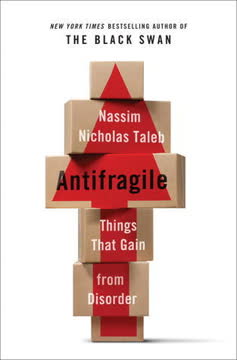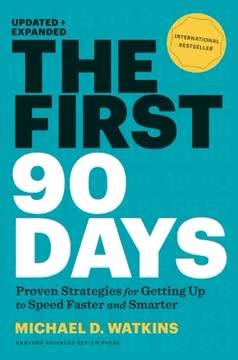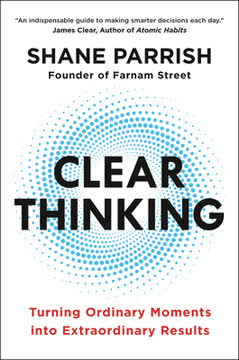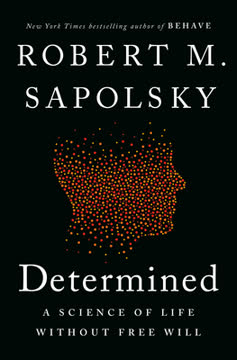Key Takeaways
1. Critical Thinking: Question Assumptions, Evaluate Evidence
When we are thinking critically, we are setting out actively to understand what is really going on by using reasoning, evaluating evidence and thinking carefully about the process of thinking itself.
Uncritical acceptance. Critical thinking is the opposite of uncritical thinking, where we accept information at face value without questioning its validity. It involves actively engaging with information, using reasoning, and evaluating evidence to understand the underlying truth. This approach helps us avoid being deceived, manipulated, or confused by misinformation.
Skepticism and objectivity. Critical thinking requires a degree of skepticism, refusing to automatically accept claims without scrutiny. It also involves striving for objectivity, setting aside personal feelings and biases to assess facts neutrally. While complete objectivity is unattainable, awareness of our biases and employing techniques to minimize their influence are essential.
Bias awareness. Recognizing and accounting for bias, both conscious and unconscious, is crucial. Unconscious biases, in particular, can subtly distort our understanding. Overcoming these biases involves self-awareness, careful evaluation of evidence, and a willingness to challenge our own assumptions.
2. Arguments: Persuasion Through Reasoning
An argument is an attempt to persuade you of the truth of a particular conclusion using reasoning.
Reasoning vs. assertion. An argument is distinct from a mere assertion, which is a statement without support. Arguments provide a line of reasoning to justify a claim, allowing for deeper understanding, evaluation, and debate. This process enables us to test ideas and arrive at more informed conclusions.
Identifying arguments. Spotting an argument involves recognizing both a conclusion and the reasoning used to support it. Indicator words like "because," "since," and "therefore" can signal the presence of an argument. However, context is also crucial, as the intent to persuade may be implicit.
Non-arguments. Descriptions, summaries, opinions, and clarifications, while informative, do not constitute arguments because they lack an attempt to persuade through reasoning. Distinguishing between these types of content is essential for critical engagement.
3. Reconstructing Arguments: Clarity Through Structure
Reconstructing an argument: identifying all its different parts, then spelling these out clearly in a standard form that allows us to see exactly how they work.
Standard form. Reconstructing an argument involves breaking it down into its core components: premises and a conclusion. Presenting the argument in standard form, with numbered premises leading to a clearly stated conclusion, enhances clarity and facilitates analysis. This process helps to identify the logical flow and potential weaknesses in the reasoning.
Assumptions. Arguments often rely on unstated assumptions. Spelling out these implicit premises is crucial for a complete understanding and evaluation of the argument. Identifying assumptions reveals hidden connections and potential vulnerabilities in the reasoning.
Principle of charity. When reconstructing an argument, it's important to apply the principle of charity, assuming the author is truthful and reasonable. This involves presenting the argument in its strongest possible form before subjecting it to critical analysis. This approach ensures a fair and thorough evaluation.
4. Deductive Reasoning: Logic and Certainty
When used correctly, deductive reasoning is guaranteed to preserve the truth of its premises in its conclusion (just so long as they’re true in the first place).
Truth-preserving. Deductive reasoning involves drawing conclusions that necessarily follow from given premises. If the premises are true and the argument is valid, the conclusion is guaranteed to be true. This truth-preserving quality makes deductive reasoning a powerful tool for logical analysis.
Validity vs. truth. Deductive reasoning focuses on the structure of arguments, not the truth of their content. An argument can be valid even if its premises are false. Validity ensures that the conclusion follows logically from the premises, regardless of their actual truth.
Necessary and sufficient conditions. Understanding necessary and sufficient conditions is crucial for deductive reasoning. A necessary condition must be met for something to be true, while a sufficient condition guarantees its truth. Confusing these conditions leads to logical fallacies.
5. Inductive Reasoning: Observation and Probability
Inductive reasoning: a form of reasoning in which premises strongly support a conclusion, but where we can never be absolutely certain that it is true.
Generalization. Inductive reasoning involves making generalizations based on observations. Unlike deductive reasoning, inductive arguments do not guarantee the truth of their conclusions. Instead, they offer varying degrees of support, making the conclusion more or less probable.
Inductive force. The strength of an inductive argument depends on the quality and quantity of evidence. A larger, more representative sample generally leads to a stronger argument. However, even the strongest inductive argument remains subject to uncertainty.
Uncertainty. Recognizing the inherent uncertainty of inductive reasoning is crucial. While we can strive to make our inferences as reliable as possible, we must acknowledge that our conclusions are always provisional and subject to revision in light of new evidence.
6. Abductive Reasoning: Explanations and Theories
Critical thinking helps us to search for the best account we can find of the way things actually are.
Inference to the best explanation. Abductive reasoning, also known as "inference to the best explanation," involves developing theories to explain observed phenomena. It seeks to identify the most likely cause or underlying mechanism that accounts for the available evidence. This form of reasoning is central to scientific inquiry and problem-solving.
Criteria for good explanations. A good explanation should account for all available evidence and be as simple as possible. It should not ignore inconvenient facts or introduce unnecessary assumptions. Simpler explanations that account for all the facts are generally preferable to more complex ones.
Scientific method. Abductive reasoning is closely linked to the scientific method, which involves formulating hypotheses, testing them through observation and experiment, and refining or rejecting them based on the evidence. This iterative process helps us to develop increasingly accurate and reliable explanations of the world.
7. Rhetoric: Persuasion Beyond Reason
Rhetoric is the attempt to persuade by appealing to emotions rather than by using reasoning.
Emotional appeals. Rhetoric encompasses the art of persuasion through means other than reasoning, primarily by appealing to emotions. While rhetoric is not inherently bad, it's crucial to recognize its influence and disentangle it from the underlying reasoning.
Elements of persuasion. Classical rhetoric identifies three key elements: ethos (establishing credibility), logos (presenting a logical argument), and pathos (appealing to emotions). Effective persuasion often involves a skillful combination of these elements.
Critical engagement. Recognizing rhetorical devices and emotional appeals is essential for critical engagement. By identifying these techniques, we can better assess the underlying reasoning and avoid being swayed by manipulation.
8. Fallacies: Spotting Faulty Reasoning
A fallacy is a flawed general type of argument that establishes a faulty connection between premises and conclusion, thus failing to give us a good reason to accept the conclusion.
Identifying fallacies. Fallacies are flawed patterns of reasoning that lead to invalid conclusions. Recognizing common fallacies helps us to identify weaknesses in arguments and avoid making similar errors in our own thinking.
Informal vs. formal fallacies. Informal fallacies involve errors in content or context, while formal fallacies involve errors in logical structure. Understanding this distinction is crucial for accurately diagnosing faulty reasoning.
Common fallacies. Familiarizing yourself with common fallacies, such as appeals to emotion, ad hominem attacks, and false dilemmas, equips you to critically evaluate arguments and avoid being misled by faulty reasoning.
9. Cognitive Biases: Understanding Mental Short Cuts
Critical thinking skills are not just about learning information: they’re part of metacognition, meaning thinking about thinking itself.
Heuristics. Cognitive biases arise from mental short cuts, or heuristics, that our brains use to simplify complex decisions. While heuristics are often helpful, they can also lead to predictable errors in judgment.
Common biases. Understanding common cognitive biases, such as the availability heuristic, anchoring effect, and confirmation bias, helps us to recognize and mitigate their influence on our thinking.
Self-awareness. Recognizing our own susceptibility to cognitive biases is crucial for critical thinking. By becoming more aware of these biases, we can take steps to minimize their impact on our judgments and decisions.
10. Overcoming Bias: Strategies for Clearer Thinking
The art of critical thinking isn’t about changing human nature, or pretending we can or should act entirely rationally all the time.
Distrust intuition. Overcoming bias involves learning to distrust our intuitions, especially in situations where they are likely to be unreliable. This requires slowing down, thinking critically, and seeking cognitive reinforcements.
Consider alternative histories. Outcome bias and survivorship bias can distort our understanding of events. By considering alternative histories and focusing on processes rather than outcomes, we can gain a more accurate perspective.
Embrace uncertainty. Acknowledging the inherent uncertainty of the world is crucial for avoiding overconfidence and making sound judgments. This involves recognizing the limitations of our knowledge and being open to new information.
11. Technology: Critical Engagement in a Digital Age
We need to be equipped to think as critically as possible about thinking itself if we are to succeed in this context – and we need strategies for taking full advantage of our unprecedented intercon-nectivity through technology, rather than simply finding ourselves swept along by its momentum.
Information vs. knowledge. In a digital age, it's crucial to distinguish between data, information, and knowledge. Data is raw and unprocessed, information is structured and contextualized data, and knowledge is verified information that we have good reason to believe is true.
System biases. Information systems are not neutral tools. They encode biases and assumptions that can influence our thinking. Recognizing these system biases, such as network effects, algorithmic bias, and structural recency bias, is essential for critical engagement.
Attention management. Time and attention are scarce resources in a digital age. Managing our attention effectively involves prioritizing tasks, batching activities, and embracing boundaries to avoid distractions and maintain focus.
12. Action: Habits for Critical Thinking in Life
Critical thinking helps us to search for the best account we can currently offer of the way things actually are – and this means being obliged to change our minds when facts and reason demand that we do.
Continuous learning. Critical thinking is not a one-time skill but an ongoing process of learning, reflection, and adaptation. It requires a commitment to lifelong learning and a willingness to challenge our own beliefs.
Habit formation. Cultivating habits that support critical thinking, such as reading widely, seeking diverse perspectives, and questioning assumptions, is essential for long-term success.
Practical application. The ultimate goal of critical thinking is to improve our decision-making, problem-solving, and communication skills in all aspects of life. By applying these principles to our studies, work, and personal relationships, we can become more effective and engaged citizens of the world.
Last updated:
FAQ
What's Critical Thinking: Your Guide to Effective Argument, Successful Analysis and Independent Study about?
- Focus on Reasoning: The book by Tom Chatfield emphasizes the importance of reasoning in understanding and constructing arguments. It guides readers through the process of critical thinking.
- Two-Part Structure: It is divided into two parts: one on becoming a reasonable thinker and the other on navigating a world filled with biases and misinformation.
- Practical Application: Chatfield provides practical tools and techniques for applying critical thinking in everyday life, academic work, and professional settings.
Why should I read Critical Thinking by Tom Chatfield?
- Enhance Analytical Skills: The book helps improve your ability to analyze arguments and evidence critically, which is essential in today’s information-rich environment.
- Combat Bias: It equips readers with strategies to recognize and overcome cognitive biases, enabling more objective decision-making.
- Develop Confidence: By learning critical thinking skills, you will become a more confident and effective communicator, able to express your ideas clearly and persuasively.
What are the key takeaways of Critical Thinking?
- Understanding Arguments: Learn to identify, reconstruct, and evaluate arguments, focusing on premises and conclusions.
- Types of Reasoning: The book discusses deductive, inductive, and abductive reasoning and their applications in forming sound arguments.
- Navigating Information: Gain insights on critically engaging with information, especially in the digital age, where misinformation is prevalent.
How does Tom Chatfield define critical thinking in Critical Thinking?
- Active Engagement: Chatfield defines it as actively seeking to understand what is really going on by evaluating information and reasoning carefully.
- Opposite of Uncritical Thinking: It contrasts with uncritical thinking, where individuals accept information at face value without questioning its validity.
- Toolkit for Reasoning: The book presents critical thinking as a toolkit of techniques that can be applied to various contexts, enhancing one’s ability to think independently.
What is the principle of charity in Critical Thinking?
- Assume Good Intent: The principle suggests assuming that others are truthful and reasonable when reconstructing their arguments.
- Strengthen Understanding: By interpreting arguments in their strongest form, you can better analyze and engage with them, leading to more productive discussions.
- Avoid Straw Man Arguments: This principle helps prevent misrepresenting an opponent's position, allowing for a fairer and more rigorous debate.
What are the different types of reasoning discussed in Critical Thinking?
- Deductive Reasoning: Involves drawing specific conclusions from general premises, ensuring that if the premises are true, the conclusion must also be true.
- Inductive Reasoning: Seeks to generalize from specific observations, allowing for conclusions that are likely but not guaranteed to be true.
- Abductive Reasoning: Aims to find the best possible explanation for a set of observations, often leading to hypotheses that can be tested.
How does Critical Thinking address cognitive biases?
- Identification of Biases: Chatfield identifies various cognitive biases, such as confirmation bias and the Dunning-Kruger effect, that impact our reasoning.
- Strategies for Mitigation: Provides strategies to counteract these biases, such as employing critical thinking techniques and being aware of emotional influences on decision-making.
- Real-World Examples: Uses real-world examples to illustrate how cognitive biases manifest in everyday situations, helping readers relate the concepts to their own experiences.
What is the difference between correlation and causation in Critical Thinking?
- Understanding Relationships: Correlation refers to a relationship between two variables, while causation implies that one variable directly affects the other.
- Avoiding Misinterpretation: The book warns against confusing correlation with causation, which can lead to faulty conclusions and reasoning.
- Importance in Research: Recognizing this distinction is crucial in research and critical analysis, as it affects how we interpret data and evidence.
What are some common fallacies discussed in Critical Thinking?
- Ad Hominem Fallacy: Occurs when an argument attacks the person making the argument rather than addressing the argument itself.
- Appeal to Popularity: Suggests that a claim is true simply because many people believe it, emphasizing that popularity does not equate to truth.
- Slippery Slope: Assumes that a small first step will inevitably lead to a chain of related events resulting in significant consequences.
What is the affect heuristic mentioned in Critical Thinking?
- Emotional Decision-Making: Refers to the tendency to rely on emotional responses when making decisions, leading to quick judgments not based on rational analysis.
- Influence of Feelings: Our feelings about a situation can heavily influence our perceptions of its risks and benefits, often overshadowing more objective assessments.
- Practical Implications: Understanding the affect heuristic can help individuals recognize when their emotions are guiding their decisions, allowing for more balanced and rational choices.
What are some practical techniques for improving critical thinking skills according to Critical Thinking?
- Self-Assessment: Encourages readers to assess their own critical thinking abilities through self-reflection and evaluation of their reasoning skills.
- Structured Argumentation: Provides a framework for reconstructing arguments in standard form, helping to clarify reasoning and identify assumptions.
- Engaging with Diverse Perspectives: Suggests actively seeking out and engaging with differing viewpoints to enhance understanding and critical analysis.
What are the best quotes from Critical Thinking and what do they mean?
- "Never trust a good story": Emphasizes the need for skepticism when encountering compelling narratives, as anecdotes can be persuasive but are not reliable evidence for broader claims.
- "Seek refutation over confirmation": Highlights the importance of challenging one's own beliefs to strengthen arguments and enhance understanding.
- "Every option you’re given can be wrong": Serves as a reminder to question the choices presented to us, encouraging critical thinking and the exploration of alternative perspectives.
Review Summary
Critical Thinking by Tom Chatfield is highly praised for its accessible approach to complex topics. Readers appreciate its practical exercises, clear explanations, and comprehensive coverage of critical thinking skills. Many found it useful for students and general readers alike, highlighting its insights on cognitive biases, logical reasoning, and information analysis. The book's structure and writing style received positive feedback, though some felt it could be dense or repetitive at times. Overall, it's considered a valuable resource for developing critical thinking abilities in the modern information age.
Similar Books







Download PDF
Download EPUB
.epub digital book format is ideal for reading ebooks on phones, tablets, and e-readers.





